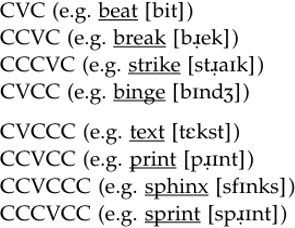
English Syllable Phonotactics
 المؤلف:
Mehmet Yavas̡
المؤلف:
Mehmet Yavas̡
 المصدر:
Applied English Phonology
المصدر:
Applied English Phonology
 الجزء والصفحة:
P139-C6
الجزء والصفحة:
P139-C6
 2025-03-12
2025-03-12
 624
624
English Syllable Phonotactics
While we were talking about the syllabification of words that involve the use of two or more consonants in a row between vowels, the determination regarding which syllable they should belong to was made with reference to language-specific facts. For example, a word such as acne [ækni] will have the f irst consonant as the coda of the first syllable, and the second consonant as the onset of the second syllable. The obvious reason is that English does not allow /kn/ as an onset cluster. This will not be the case if we are talking about Norwegian (e.g. Knut), Hebrew (e.g. Knesset), Russian (e.g. kniga), or German (e.g. Knabe). It is time now to deal with the specifics of English syllable structure.
We start with the general formula, which can be stated as:

What this characterization says is that a V (vowel or diphthong), which is the nucleus, is the only obligatory element in an English syllable (e.g. a [e]). The surrounding consonants in parentheses are optional elements. Thus, we can have a V with one, two, or three consonants before it as single, double, or triple onsets:

Just as we can add consonants as onsets, we can add them as codas after the nucleus:

In the general formula given at the outset, there is also a fourth consonant in the coda, given in brackets. This is different than the others, because it is possible only if it belongs to a suffix, that is, if it comes from the following morpheme, as in bursts [bɝsts]. Single and multiple onsets can also be combined with single and multiple codas and create further possibilities:

Beyond these, the following are possible if we include suffixes:

CCCVCCCC is a logical possibility with no commonly found vocabulary.
The picture given above is still a very general one and does not include the numerous restrictions we have on onsets and codas.
 الاكثر قراءة في Phonology
الاكثر قراءة في Phonology
 اخر الاخبار
اخر الاخبار
اخبار العتبة العباسية المقدسة


